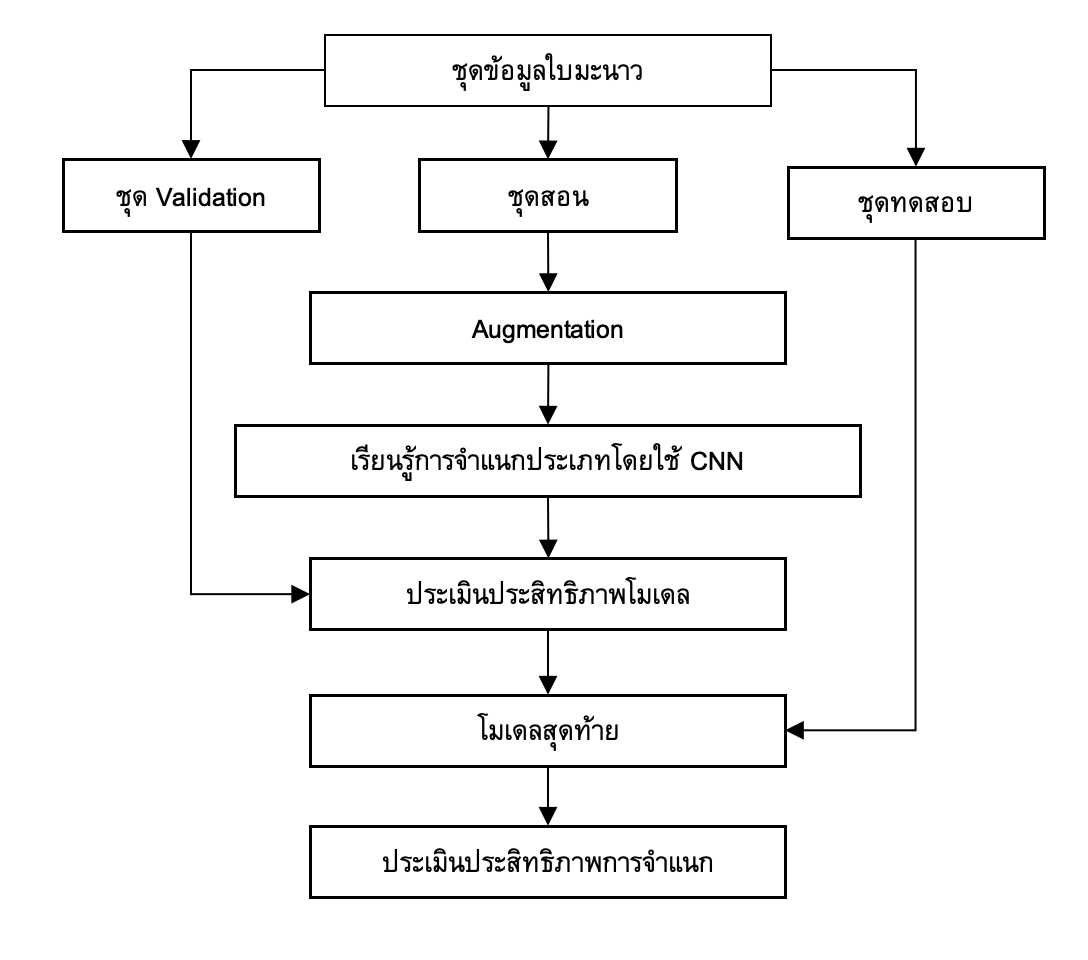Analysis of Lime Leaf Disease using Deep Learning
Main Article Content
Abstract
Currently, lime is a type of plant that has been cultivated in many places. Because limes are used in cooking, and their properties are herb. In Thailand, limes are used for drinking and medical herb to used in health care. From this popularity, the cultivation of limes became widespread and began to be planted more in farm and more at home. Nowadays, lime cultivation can be controlled to produce off-season produce. However, lime is also prone to diseases without proper care. For these reasons, this research is to study the analyzation of decease from lime leaves by using deep learning. The Convolutional Neural Networks (CNNs) of deep learning is used to classify the decease. The proposed architecture of CNNs in this study is to compare to LeNet-5, VGG16, and RestNet-50 architectures. The total number of single lime leaf images is 5,710. The input images are RGB color. The normal and decease lime leaves are separated in equal. Training and test sets are 80 and 20 percent, respectively. The evaluation result is found that LeNet-5 has the lowest accuracy, while the proposed architecture has the highest accuracy but it is not different from ResNet-50.
Article Details

This work is licensed under a Creative Commons Attribution-NonCommercial-NoDerivatives 4.0 International License.
All authors need to complete copyright transfer to Journal of Applied Informatics and Technology prior to publication. For more details click this link: https://ph01.tci-thaijo.org/index.php/jait/copyrightlicense
References
Bengio, Y. (2009). Learning deep architectures for AI. Technical Report, Universite ́ de Montre ́al.
Das, S. (2017). CNN architectures: LeNet, AlexNet, VGG, GoogLeNet, ResNet and more. Retrieved 15 November 2018, Retrieved from https://medium.com/@sidereal/cnns-architectures-lenet-alexnet-vgg-googlenet-resnet-and-more-666091488df5
Deng, L., & Yu, D. (2013). Deep learning: Method and application. In Foundations and Trends in Signal Processing, 7, 197-387.
Fawcett, T. (2006). An introduction to ROC analysis. Pattern Recognition Letters, 27(8), 861–874.
Guo, Y., Wang, D., & Zhu, H. (2018). Recognition of a plant leaf based on convolutional neural networks. In Tenth International Conference on Digital Image Processing (ICDIP). SPIE. https://doi.org/10.1117/12.2503098
He, K., Zhang, X., Ren, S., & Sun, J. (2016). Deep residual learning for image recognition. In the IEEE Conference on Computer Vision and Pattern Recognition (CVPR) (pp. 770-778). IEEE.
Hinton, G.E., & Salakhutdinov, R.R. (2006). Reducing the dimensionality of data with neural network. Science, 313, 504-507.
Krizhevsky, A., Sutskever, I., & Hinton, G.E. (2017). ImageNet Classification with Deep Convolutional Neural Networks. Communications of the ACM. 84-90. http://doi.org.10.1145/3065386
Krizhevsky, A., Sutskever, I., & Hinton, G.E. (2012). AlexNet. Advances in Neural Information Processing Systems, 1-9.
LeCun, Y., & Bengio, Y. (1998). Convolutional networks for images, speech, and time series. In Arbib, M.A. (Ed.), The Handbook of Brain Theory and Neural Networks (pp. 255-258). MIT Press.
LeCun, Y., Bottou, L., Bengio, Y., & Haffner, P. (1998). Gradient-based learning applied to document recognition. Proceedings of the IEEE, 86, 2278-2324.
Okafor, E., Pawara, P., Karaaba, F., Surinta, O., Codreanu, V., Schomaker, L., & Wiering, M. (2016). Comparative study between deep learning and bag of visual words for wild-animal recognition. In IEEE Symposium Series on Computational Intelligence (SSCI) (pp. 1-8). IEEE.
Pawara, P., Okafor, E., Schomaker, L., & Wiering, M. (2017). Data augmentation for plant classification. In International Conference on Advanced Concepts for Intelligent Vision Systems (ACIVS) (pp. 615-626). Springer.
Simonyan, K., & Zisserman, A. (2014). Very deep convolutional networks for large-scale image recognition. arXiv preprint arXiv:1409.1556. Retrieved from http://arxiv.org/abs/1409.1556
Szegedy, C., Liu, W., Jia, Y., Sermanet, P., Reed, S., Anguelov, D., and Rabinovich, A. (2015). Going deeper with convolutions. In Computer Vision and Pattern Recognition (CVPR). Retrieved from http://arxiv.org/abs/1409.4842
Wicht, B., & Henneberty, J. (2015). Mixed handwritten and printed digit recognition in Sudoku with convolutional deep belief network. In the 13th International Conference on Document Analysis and Recognition (ICDAR) (pp. 861-865). IEEE. https://doi.org/10.1109/ICDAR.2015.7333884
Zeiler, M.D., & Fergus, R. (2014). Visualizing and understanding convolutional networks. In 13th European Conference on Computer Vision (ECCV). Springer, Cham.






